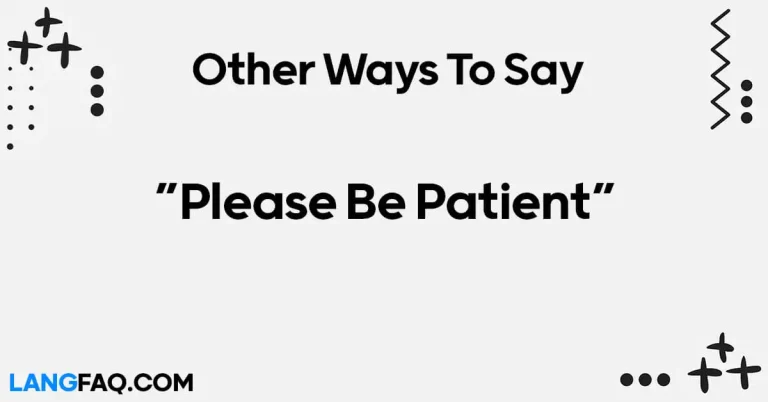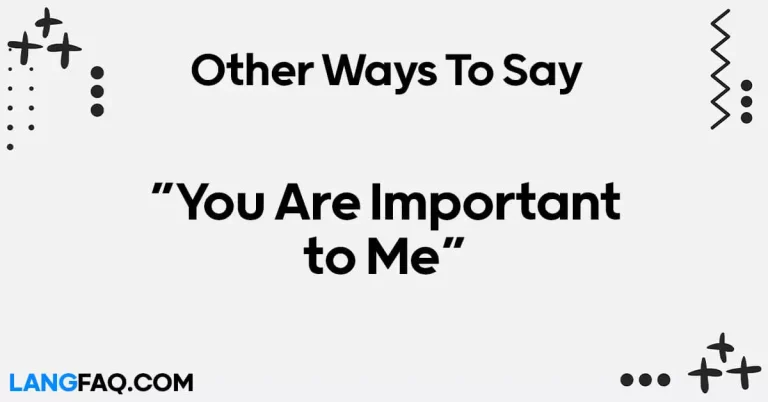Communication is the cornerstone of human interaction. Whether in personal relationships or professional settings, expressing oneself clearly is essential. However, there are times when the phrase “Please let me know your thoughts” might feel overused or lacks the desired impact. Fear not! In this article, we delve into 12 alternative ways to express the same sentiment, adding flair and variety to your communication toolkit.
12 Other Ways to Say “Please Let Me Know Your Thoughts”
Here are 12 alternative ways to say “Please let me know your thoughts”:
- I’d love to hear your perspective.
- What’s your take on this?
- I’m eager to know what you think.
- Could you share your insights?
- Your opinion would be greatly appreciated.
- Feel free to give your input.
- How do you feel about this?
- I’m open to your feedback.
- Any thoughts you’d like to share?
- Let me know if you have any ideas.
- Share your thoughts whenever you’re ready.
- I value your opinion—please share it with me.
Here’s a table with the meanings and examples of the 12 alternative ways to say “Please let me know your thoughts”:
| Alternative Phrase | Meaning | Example |
|---|---|---|
| I’d love to hear your perspective. | Expressing interest in someone’s viewpoint. | “Before we finalize the decision, I’d love to hear your perspective.” |
| What’s your take on this? | Asking for someone’s opinion or viewpoint. | “What’s your take on the new project proposal?” |
| I’m eager to know what you think. | Showing enthusiasm to hear someone’s thoughts. | “I’m eager to know what you think about the latest marketing strategy.” |
| Could you share your insights? | Requesting someone to provide their insights or expertise. | “Could you share your insights on the market trends?” |
| Your opinion would be greatly appreciated. | Expressing gratitude for someone’s opinion. | “Your opinion would be greatly appreciated on this matter.” |
| Feel free to give your input. | Inviting someone to contribute their ideas. | “Feel free to give your input during the brainstorming session.” |
| How do you feel about this? | Asking for someone’s emotional response or opinion. | “How do you feel about the new company policy?” |
| I’m open to your feedback. | Indicating receptiveness to receive criticism or suggestions. | “I’m open to your feedback on the draft proposal.” |
| Any thoughts you’d like to share? | Inviting someone to share their thoughts or ideas. | “Any thoughts you’d like to share about the upcoming project?” |
| Let me know if you have any ideas. | Requesting someone to offer their suggestions or thoughts. | “Let me know if you have any ideas for improving our website.” |
| Share your thoughts whenever you’re ready. | Encouraging someone to share their thoughts at their convenience. | “Feel free to share your thoughts whenever you’re ready.” |
| I value your opinion—please share it with me. | Expressing appreciation for someone’s input. | “I value your opinion—please share it with me on this matter.” |
Using diverse phrases to solicit feedback not only adds variety to communication but also fosters a more inclusive and engaging dialogue. By incorporating these alternatives, individuals can create a welcoming environment for sharing thoughts and ideas.
Is It Correct to Say “Please Let Me Know Your Thoughts”?
Yes, “Please let me know your thoughts” is a correct and commonly used phrase in English. It is often used to invite someone to share their opinions, ideas, or feedback on a particular topic or matter. This phrase is polite and straightforward, making it suitable for both formal and informal contexts.
In professional settings, it can be used in emails, meetings, or discussions to solicit input from colleagues, clients, or stakeholders. For example, a manager might say, “After reviewing the proposal, please let me know your thoughts on the suggested changes.”
In personal interactions, it can be used to initiate conversations or seek advice from friends, family, or acquaintances. For instance, someone might say, “I’m considering redecorating my living room. Please let me know your thoughts on color schemes and furniture arrangement.”
Overall, “Please let me know your thoughts” is a versatile and polite way to invite others to share their perspectives, making it a commonly used phrase in English communication.
Professional Mail Example With “Please Let Me Know Your Thoughts”
Subject: Proposal Review: Please Let Me Know Your Thoughts
Dear [Recipient’s Name],
I trust this email finds you well.
I am writing to follow up on the proposal I sent over regarding [topic/project]. I hope you’ve had the chance to review it thoroughly.
As we move forward with [project/initiative], I value your input and insights immensely. Your expertise in [relevant area] would be invaluable in ensuring the success of this endeavor.
Could you please take some time to review the proposal and let me know your thoughts? Specifically, I would appreciate any feedback or suggestions you may have regarding [specific aspect/section].
Additionally, if you have any concerns or questions, please don’t hesitate to reach out. Your perspective is crucial to ensuring that we address all aspects of the project effectively.
I have attached the proposal for your convenience. Please feel free to annotate or make any comments directly within the document.
Thank you in advance for your attention to this matter. I look forward to hearing your thoughts and discussing further steps.
Best regards,
[Your Name] [Your Position] [Your Contact Information]
Seeking Input: I’d Love to Hear Your Perspective
When it comes to soliciting feedback, expressing genuine interest in someone’s perspective can go a long way. “I’d love to hear your perspective” is a warm and inviting way to encourage others to share their thoughts and ideas. This phrase acknowledges the value of the individual’s viewpoint and sets a positive tone for the conversation.
Formal Context: In a professional setting, using this phrase demonstrates respect for the expertise and insights of colleagues or team members. For example, during a brainstorming session, a team leader might say, “As we consider different marketing strategies, I’d love to hear your perspective on which approach might resonate best with our target audience.”
Informal Context: Among friends or in casual conversations, this phrase can be used to invite someone to share their thoughts on a personal matter. For instance, when discussing travel plans, one friend might say to another, “I’d love to hear your perspective on which destination we should choose for our next trip.”
Variations:
- “I’m interested in your viewpoint.”
- “What are your thoughts on this?”
- “Could you share your insights?”
Example Sentence: “Before we finalize the project plan, I’d love to hear your perspective on how we can streamline our processes for better efficiency.”
Email Sample:
Subject: Seeking Your Perspective on Project Strategy
Hi [Recipient’s Name],
I hope this email finds you well. As we delve into refining our project strategy for the upcoming quarter, I’d love to hear your perspective on how we can optimize our approach to meet our goals effectively. Your insights are invaluable to our team’s success, and I’m eager to incorporate your ideas into our plan.
Looking forward to hearing from you soon.
Best regards, [Your Name]
Dictionary Insights: According to Cambridge Dictionary, “perspective” refers to a particular way of considering something, and seeking someone’s perspective implies valuing their unique viewpoint on a given matter.
Usage Tips: When using this phrase, ensure sincerity in your tone to convey genuine interest in the other person’s opinion. Avoid using it as a mere formality; instead, actively listen to and consider the perspectives shared.
Pros:
- Encourages open dialogue and collaboration.
- Demonstrates respect for diverse viewpoints.
- Fosters a positive and inclusive work environment.
Cons:
- May not be suitable for situations where a quick decision is required.
- Requires active listening and follow-up actions to validate the importance of the shared perspective.
What’s Your Take on This?: Inviting Opinions and Insights
In the realm of communication, asking for someone’s take on a matter is an effective way to invite opinions and insights. “What’s your take on this?” is a versatile phrase that prompts others to share their thoughts in a concise yet comprehensive manner.
Formal Context: In a professional context, using this phrase can facilitate discussions during meetings or presentations. For instance, a team leader might ask, “Before we proceed with the project plan, what’s your take on the proposed timeline and milestones?”
Informal Context: Among friends or in casual conversations, this phrase can be used to initiate discussions on various topics. For example, when discussing a recent movie, one friend might ask another, “What’s your take on the ending? Did you interpret it differently?”
Variations:
- “What’s your opinion on this matter?”
- “How do you see this situation?”
- “What’s your perspective on the issue?”
Example Sentence: “As we consider different marketing strategies, what’s your take on leveraging social media platforms to engage with our target audience?”
Email Sample:
Subject: Seeking Your Input on Project Approach
Hey [Recipient’s Name],
I hope you’re doing well. I wanted to reach out and get your take on our approach to the upcoming project. Your insights are always valuable, and I’m eager to hear your perspective on how we can refine our strategy for maximum impact.
Looking forward to hearing from you soon!
Best, [Your Name]
Dictionary Insights: According to Merriam-Webster, “take” can refer to a particular way of regarding or considering something. Asking for someone’s take implies a desire to understand their unique viewpoint or interpretation.
Usage Tips: When using this phrase, ensure clarity in your communication to prompt specific feedback or opinions. Encourage individuals to express their take on the matter freely without fear of judgment.
Pros:
- Encourages active participation and engagement.
- Prompts individuals to articulate their opinions succinctly.
- Facilitates meaningful discussions and decision-making processes.
Cons:
- May not yield detailed insights if the question is too broad or ambiguous.
- Requires follow-up questions to delve deeper into specific aspects of the topic.
I’m Eager to Know What You Think: Expressing Enthusiasm for Feedback
Expressing eagerness to know what others think is a powerful way to encourage open communication and collaboration. “I’m eager to know what you think” conveys genuine interest in someone’s thoughts and ideas, fostering a positive and supportive environment for sharing feedback.
Formal Context: In professional settings, using this phrase can demonstrate proactive engagement in decision-making processes. For example, a project manager might say, “As we review the latest market trends, I’m eager to know what you think about potential strategies for expansion.”
Informal Context: Among friends or in casual conversations, this phrase can be used to express curiosity about personal preferences or opinions. For instance, when discussing weekend plans, one friend might say to another, “I’m eager to know what you think about trying out that new restaurant downtown.”
Variations:
- “I’m excited to hear your thoughts.”
- “I’m looking forward to hearing your perspective.”
- “I can’t wait to hear what you have to say.”
Example Sentence: “Before finalizing the agenda for the meeting, I’m eager to know what you think about adding a discussion on team collaboration strategies.”
Email Sample:
Subject: Seeking Your Input on Project Strategy
Hi [Recipient’s Name],
Hope you’re doing well! As we navigate through the planning phase of our project, I’m eager to know what you think about our proposed approach. Your insights are invaluable, and I’m excited to hear your perspective on how we can achieve our objectives effectively.
Looking forward to your thoughts!
Best regards, [Your Name]
Dictionary Insights: According to Oxford Languages, “eager” means showing keen interest or intense desire. Expressing eagerness to know what someone thinks implies a genuine desire to hear their thoughts or opinions.
Usage Tips: When using this phrase, maintain a positive and enthusiastic tone to convey genuine interest in the other person’s input. Avoid using it in situations where immediate feedback may not be feasible or appropriate.
Pros:
- Demonstrates enthusiasm for collaboration and feedback.
- Creates a welcoming environment for sharing thoughts and ideas.
- Encourages active participation and engagement in discussions.
Cons:
- May come across as insincere if not accompanied by genuine interest in hearing others’ perspectives.
- Requires follow-up actions to validate the importance of the shared feedback and ideas.
Could You Share Your Insights?: Requesting Valuable Input
Requesting someone to share their insights is a polite and effective way to solicit valuable input. “Could you share your insights?” acknowledges the expertise and experience of the individual, inviting them to contribute their unique perspective to the discussion.
Formal Context: In professional environments, using this phrase demonstrates respect for the expertise of colleagues or team members. For example, a project lead might say, “As we analyze the market data, could you share your insights on potential customer preferences?”
Informal Context: Among peers or in informal settings, this phrase can be used to seek advice or opinions on various topics. For instance, when discussing a recent book, one friend might ask another, “Could you share your insights on the author’s writing style?”
Variations:
- “Can you provide some insights on this?”
- “I’d love to hear your expert opinion.”
- “What are your thoughts based on your experience?”
Example Sentence: “Before we finalize the proposal, could you share your insights on how we can enhance the project’s feasibility?”
Email Sample:
Subject: Seeking Your Insights on Marketing Strategy
Hey [Recipient’s Name],
Hope you’re doing well! I’m currently reviewing our marketing strategy for the upcoming campaign, and I would greatly appreciate it if you could share your insights on potential target demographics and messaging approaches. Your expertise in this area would be invaluable to our team’s success.
Looking forward to hearing from you soon!
Best regards, [Your Name]
Dictionary Insights: According to Collins Dictionary, “insights” refer to the ability to understand and see into the true nature of something. Requesting someone to share their insights implies valuing their unique perspective and understanding of a given topic.
Usage Tips: When using this phrase, be specific about the topic or issue for which you’re seeking insights to prompt focused feedback. Avoid using it as a generic request for input, as it may lead to vague or unhelpful responses.
Pros:
- Demonstrates respect for the expertise and experience of others.
- Encourages individuals to share their unique perspectives and knowledge.
- Promotes collaboration and informed decision-making.
Cons:
- May not yield detailed insights if the question is too broad or vague.
- Requires follow-up questions to clarify or expand upon the insights shared.
Your Opinion Would Be Greatly Appreciated: Expressing Gratitude for Feedback
Expressing appreciation for someone’s opinion is a polite way to encourage them to share their thoughts. “Your opinion would be greatly appreciated” conveys gratitude for the individual’s input and acknowledges the value of their perspective in the discussion.
Formal Context: In professional settings, using this phrase can show respect for the expertise and insights of colleagues or stakeholders. For example, a project manager might say, “As we finalize the budget proposal, your opinion would be greatly appreciated in determining the allocation of resources.”
Informal Context: Among friends or in casual conversations, this phrase can be used to seek advice or opinions on personal matters. For instance, when discussing vacation plans, one friend might say to another, “Your opinion would be greatly appreciated in choosing the destination.”
Variations:
- “I would value your opinion on this matter.”
- “Your input is highly valued.”
- “We would be grateful for your thoughts.”
Example Sentence: “Before we proceed with the decision, your opinion would be greatly appreciated on how we can improve customer satisfaction.”
Email Sample:
Subject: Seeking Your Opinion on Project Strategy
Hi [Recipient’s Name],
I hope this email finds you well. As we evaluate our project strategy moving forward, I wanted to reach out and express how much your opinion would be greatly appreciated in shaping our approach. Your insights have always been invaluable to our team’s success, and I’m eager to hear your thoughts on the matter.
Looking forward to your input!
Best regards, [Your Name]
Dictionary Insights: According to Lexico, “appreciated” means recognized and valued for one’s qualities or efforts. Expressing that someone’s opinion would be greatly appreciated conveys recognition and gratitude for their input.
Usage Tips: When using this phrase, ensure sincerity in expressing gratitude for the individual’s opinion. Avoid using it as a mere formality; instead, demonstrate genuine appreciation for their insights.
Pros:
- Demonstrates respect and appreciation for others’ input.
- Encourages individuals to share their perspectives confidently.
- Fosters a positive and collaborative work environment.
Cons:
- May not be suitable for situations where immediate decisions are required.
- Requires follow-up actions to validate the importance of the shared opinion.
Feel Free to Give Your Input: Inviting Contributions and Ideas
Inviting others to give their input is a welcoming way to encourage participation and collaboration. “Feel free to give your input” empowers individuals to share their ideas and perspectives without hesitation, fostering a culture of inclusivity and openness.
Formal Context: In professional environments, using this phrase can facilitate discussions and decision-making processes. For example, a team leader might say, “As we brainstorm potential solutions, feel free to give your input on how we can address this challenge.”
Informal Context: Among friends or in casual settings, this phrase can be used to encourage everyone to contribute to a conversation or decision. For instance, when planning a group outing, one friend might say, “Feel free to give your input on the activities you’d like to do.”
Variations:
- “We welcome your input.”
- “Don’t hesitate to share your ideas.”
- “Feel free to chime in with your thoughts.”
Example Sentence: “As we finalize the agenda for the meeting, feel free to give your input on any additional topics you think should be included.”
Email Sample:
Subject: Seeking Your Input on Project Timeline
Hey [Recipient’s Name],
Hope you’re doing well! I’m currently revising the project timeline, and I wanted to reach out and encourage you to feel free to give your input on any adjustments or considerations you think are necessary. Your expertise in this area would be invaluable to ensuring the success of the project.
Looking forward to hearing from you!
Best regards, [Your Name]
Dictionary Insights: According to Merriam-Webster, “input” refers to advice, opinions, or information that is used to make decisions. Inviting others to give their input acknowledges the value of their contributions to the discussion.
Usage Tips: When using this phrase, create a supportive environment where individuals feel comfortable sharing their ideas and perspectives. Encourage active participation and ensure that all voices are heard and respected.
Pros:
- Empowers individuals to contribute their ideas and perspectives.
- Fosters a culture of inclusivity and collaboration.
- Leads to more informed decision-making and problem-solving.
Cons:
- May lead to lengthy discussions if not managed effectively.
- Requires active facilitation to ensure that all viewpoints are considered and addressed.
How Do You Feel About This?: Prompting Emotional Responses and Opinions
Prompting others to share how they feel about a situation or topic can lead to deeper insights and understanding. “How do you feel about this?” invites individuals to express their emotional responses and personal opinions, fostering empathy and connection in communication.
Formal Context: In professional settings, using this phrase can help gauge the emotional impact of decisions or actions on team members. For example, a manager might say, “Considering the recent changes, how do you feel about the new direction the project is taking?”
Informal Context: In personal conversations or among friends, this phrase can be used to empathize and connect on a deeper level. For instance, when discussing a challenging situation, one friend might ask another, “How do you feel about what happened?”
Variations:
- “What are your thoughts and feelings on this?”
- “How does this make you feel?”
- “I’m interested in hearing your emotional response.”
Example Sentence: “As we discuss potential changes to the company policies, I’m curious to hear how you feel about the proposed adjustments.”
Email Sample:
Subject: Seeking Your Thoughts and Feelings on Team Dynamics
Hi [Recipient’s Name],
I hope you’re doing well. I wanted to reach out and get your perspective on the recent changes in our team dynamics. How do you feel about the new structure, and what are your thoughts on how we can adapt to these changes effectively?
Looking forward to hearing from you.
Best regards, [Your Name]
Dictionary Insights: According to Oxford Languages, “feel” refers to experiencing an emotion or physical sensation. Asking someone how they feel about a situation acknowledges the emotional aspect of their response and invites them to share their emotional state.
Usage Tips: When using this phrase, create a supportive environment where individuals feel comfortable expressing their emotions. Listen actively and empathize with their responses to foster deeper connections and understanding.
Pros:
- Encourages emotional expression and empathy.
- Promotes deeper insights and understanding of others’ perspectives.
- Strengthens relationships through authentic communication.
Cons:
- May lead to sensitive or uncomfortable discussions if not approached with sensitivity.
- Requires active listening and empathy to validate and respond to emotional responses appropriately.
I’m Open to Your Feedback: Inviting Constructive Criticism and Suggestions
Being open to feedback is essential for personal and professional growth. “I’m open to your feedback” communicates a willingness to listen and learn from others’ perspectives, fostering a culture of continuous improvement and development.
Formal Context: In professional environments, using this phrase demonstrates humility and a commitment to excellence. For example, a team leader might say, “As we review the project outcomes, I’m open to your feedback on areas where we can improve for future initiatives.”
Informal Context: Among friends or in personal relationships, this phrase can be used to invite constructive criticism or suggestions for improvement. For instance, when discussing a creative project, one friend might say to another, “I’m open to your feedback on how I can enhance the design.”
Variations:
- “Please share your feedback with me.”
- “I value your input and suggestions.”
- “Feel free to offer any constructive criticism.”
Example Sentence: “As we reflect on the team’s performance, I’m open to your feedback on how we can enhance our collaboration and productivity.”
Email Sample:
Subject: Seeking Your Feedback on Presentation
Hey [Recipient’s Name],
I hope you’re doing well! I wanted to reach out and ask for your feedback on the presentation I recently delivered. I’m open to any suggestions or insights you may have on how I can improve my delivery style for future presentations.
Looking forward to hearing from you!
Best regards, [Your Name]
Dictionary Insights: According to Lexico, “feedback” refers to information about reactions to a product, performance, or process, used as a basis for improvement. Inviting feedback acknowledges the value of others’ perspectives in identifying areas for growth and improvement.
Usage Tips: When using this phrase, genuinely listen to and consider the feedback provided, even if it may be difficult to hear. Thank the individual for their input and take actionable steps to implement suggested improvements.
Pros:
- Encourages a culture of continuous improvement and learning.
- Demonstrates humility and openness to different perspectives.
- Strengthens relationships through constructive dialogue and mutual respect.
Cons:
- May lead to discomfort or defensiveness if feedback is perceived as negative or unwarranted.
- Requires active listening and humility to accept feedback gracefully and take appropriate action.
Any Thoughts You’d Like to Share?: Encouraging Contribution and Ideas
Encouraging others to share their thoughts is a proactive way to foster collaboration and innovation. “Any thoughts you’d like to share?” invites individuals to contribute their ideas and perspectives, empowering them to be active participants in discussions and decision-making processes.
Formal Context: In professional settings, using this phrase can stimulate brainstorming sessions and generate creative solutions. For example, a project manager might say, “As we explore options for the product launch, any thoughts you’d like to share on potential marketing strategies?”
Informal Context: Among friends or in casual conversations, this phrase can be used to invite everyone to contribute to a discussion. For instance, when planning a group outing, one friend might ask, “Any thoughts you’d like to share on where we should go?”
Variations:
- “Feel free to voice your thoughts.”
- “I’m interested in hearing your ideas.”
- “Do you have any input you’d like to add?”
Example Sentence: “Before we finalize the agenda for the meeting, any thoughts you’d like to share on additional topics we should cover?”
Email Sample:
Subject: Seeking Your Input on Project Strategy
Hi [Recipient’s Name],
Hope you’re doing well! I’m currently reviewing our project strategy, and I wanted to reach out and see if you have any thoughts you’d like to share on potential approaches or areas for improvement. Your insights are always valuable, and I’m eager to hear your perspective on this matter.
Looking forward to your input!
Best regards, [Your Name]
Dictionary Insights: According to Merriam-Webster, “thoughts” refer to ideas or opinions produced by thinking or occurring suddenly in the mind. Inviting others to share their thoughts acknowledges the value of their ideas and perspectives in shaping decisions and actions.
Usage Tips: When using this phrase, create a supportive environment where individuals feel comfortable expressing their ideas and opinions. Encourage active participation and ensure that all contributions are heard and respected.
Pros:
- Empowers individuals to contribute their ideas and perspectives.
- Fosters creativity and innovation through diverse viewpoints.
- Strengthens teamwork and collaboration by valuing everyone’s input.
Cons:
- May lead to lengthy discussions if not managed effectively.
- Requires active facilitation to ensure that all voices are heard and considered.
Let Me Know if You Have Any Ideas: Inviting Suggestions and Solutions
Inviting others to share their ideas is a proactive way to foster creativity and problem-solving. “Let me know if you have any ideas” encourages individuals to contribute their suggestions and solutions, empowering them to be active participants in finding solutions to challenges.
Formal Context: In professional environments, using this phrase can stimulate discussions and generate innovative solutions. For example, a team leader might say, “As we brainstorm ways to improve customer satisfaction, let me know if you have any ideas on how we can enhance our service offerings.”
Informal Context: Among friends or in personal relationships, this phrase can be used to encourage everyone to contribute to a discussion. For instance, when planning a group project, one friend might say, “Let me know if you have any ideas on how we can tackle this task.”
Variations:
- “I’m open to hearing your suggestions.”
- “Feel free to share any ideas you have.”
- “Do you have any thoughts on how we can approach this?”
Example Sentence: “Before we finalize the agenda for the meeting, let me know if you have any ideas on additional topics we should discuss.”
Email Sample:
Subject: Seeking Your Ideas for Team Building Activity
Hey [Recipient’s Name],
Hope you’re doing well! I’m currently brainstorming ideas for our upcoming team-building activity, and I wanted to reach out and see if you have any ideas you’d like to share. Your creativity and input would be greatly appreciated in making this event a success.
Looking forward to hearing from you!
Best regards, [Your Name]
Dictionary Insights: According to Oxford Languages, “idea” refers to a thought or suggestion as to a possible course of action. Inviting others to share their ideas acknowledges the value of their creativity and problem-solving abilities in finding solutions to challenges.
Usage Tips: When using this phrase, create a supportive environment where individuals feel comfortable expressing their ideas. Encourage brainstorming and ensure that all suggestions are considered and respected.
Pros:
- Encourages creativity and innovation through diverse perspectives.
- Empowers individuals to contribute to problem-solving and decision-making.
- Strengthens teamwork and collaboration by valuing everyone’s input.
Cons:
- May lead to an overwhelming number of suggestions if not managed effectively.
- Requires active facilitation to ensure that all ideas are heard and evaluated.
I’m Interested in Your Perspective: Soliciting Individual Insights
Expressing interest in someone’s perspective is a respectful way to invite them to share their unique viewpoint. “I’m interested in your perspective” communicates a genuine desire to understand the individual’s thoughts and experiences, fostering mutual respect and empathy in communication.
Formal Context: In professional settings, using this phrase can demonstrate openness to diverse viewpoints and promote inclusivity. For example, a team leader might say, “As we analyze the market data, I’m interested in your perspective on emerging trends and opportunities.”
Informal Context: Among friends or in personal conversations, this phrase can be used to deepen understanding and strengthen relationships. For instance, when discussing a recent event, one friend might say to another, “I’m interested in your perspective on what happened.”
Variations:
- “Your viewpoint is valuable to me.”
- “I’d like to hear your take on this.”
- “What are your thoughts from your point of view?”
Example Sentence: “Before we make a decision, I’m interested in your perspective on how this change might impact our team dynamics.”
Email Sample:
Subject: Seeking Your Perspective on Project Strategy
Hi [Recipient’s Name],
I hope you’re doing well. As we navigate through the planning phase of our project, I wanted to reach out and express how much I’m interested in your perspective on our proposed strategy. Your insights are invaluable, and I’m eager to hear your thoughts on how we can optimize our approach.
Looking forward to hearing from you.
Best regards, [Your Name]
Dictionary Insights: According to Merriam-Webster, “perspective” refers to a particular attitude or way of regarding something. Expressing interest in someone’s perspective acknowledges the value of their unique viewpoint and promotes understanding and empathy.
Usage Tips: When using this phrase, ensure sincerity in expressing interest in the individual’s perspective. Listen actively and empathetically to their insights, even if they differ from your own.
Pros:
- Demonstrates respect for diverse viewpoints and experiences.
- Promotes understanding and empathy in communication.
- Fosters a culture of inclusivity and mutual respect.
Cons:
- May lead to disagreements or misunderstandings if not approached with sensitivity.
- Requires active listening and empathy to validate and respond to differing perspectives appropriately.
Your Input Would Be Valuable: Acknowledging the Importance of Contribution
Acknowledging the importance of others’ input is essential for fostering collaboration and teamwork. “Your input would be valuable” communicates appreciation for the individual’s contributions and encourages them to share their insights and ideas freely.
Formal Context: In professional environments, using this phrase can demonstrate humility and a willingness to learn from others. For example, a project manager might say, “As we review the project plan, your input would be valuable in identifying potential risks and mitigation strategies.”
Informal Context: Among friends or in personal relationships, this phrase can be used to express gratitude for shared perspectives and experiences. For instance, when discussing plans for a group outing, one friend might say to another, “Your input would be valuable in deciding the activities for the day.”
Variations:
- “I appreciate your contribution to the discussion.”
- “Your insights are essential to our decision-making process.”
- “Thank you for sharing your thoughts; they are valuable to us.”
Example Sentence: “Before we finalize the budget proposal, your input would be valuable in identifying areas where we can allocate resources more effectively.”
Email Sample:
Subject: Seeking Your Input on Project Timeline
Hey [Recipient’s Name],
Hope you’re doing well! I’m currently revising the project timeline, and I wanted to reach out and let you know that your input would be valuable in ensuring that we’re on track to meet our deadlines. Your expertise in this area would be greatly appreciated.
Looking forward to hearing from you!
Best regards, [Your Name]
Dictionary Insights: According to Cambridge Dictionary, “valuable” means extremely useful or important. Acknowledging that someone’s input would be valuable conveys appreciation for their contributions and underscores their significance in the decision-making process.
Usage Tips: When using this phrase, express genuine gratitude for the individual’s contributions and actively seek their input on relevant matters. Encourage open communication and ensure that all voices are heard and respected.
Pros:
- Demonstrates humility and openness to different perspectives.
- Fosters a culture of appreciation and recognition for contributions.
- Encourages active participation and engagement in discussions and decision-making processes.
Cons:
- May lead to overwhelming feedback if not managed effectively.
- Requires active listening and follow-up actions to validate and respond to contributions appropriately.
Conclusion
Communication is not just about the words we use but also about how we convey our message. By incorporating these alternative phrases into your communication repertoire, you can invite feedback in a more engaging and effective manner. Remember, the goal is not just to solicit input but also to foster meaningful dialogue and strengthen relationships.
FAQs
- How can I encourage feedback without sounding repetitive? Using diverse expressions like “What’s your take on this?” or “Share your insights” adds variety to your communication.
- Why is it important to seek feedback? Feedback helps us gain different perspectives, improve our work, and foster collaboration.
- Can I use these phrases in both professional and personal contexts? Absolutely! These phrases are versatile and can be used in various settings to encourage open communication.
- What if someone doesn’t want to share their thoughts? Respect their decision and avoid pressuring them. Focus on creating a supportive environment where feedback is welcomed but not forced.
- How can I make my feedback requests more specific? Instead of asking, “What do you think?” try framing your request more precisely, such as, “I’d like your feedback on the project timeline. Do you see any areas for improvement?”
- Is it okay to follow up if someone hasn’t responded to my feedback request? Yes, a gentle follow-up can be appropriate, but be mindful not to come across as pushy. Respect others’ time and priorities.







